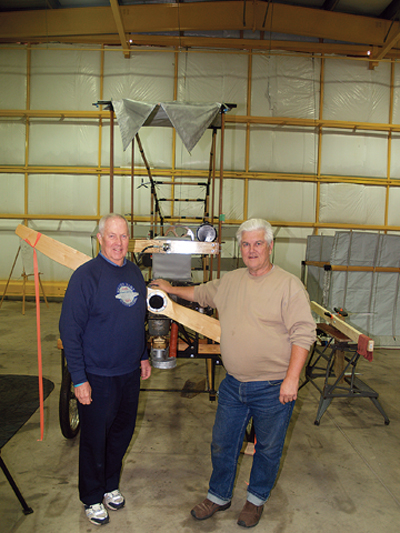
Features
Operations
A Look Back: A Labour of Love
In this year’s first issue of Wings, we began our salute to the 100th anniversary of flight, both in Canada and in the British Empire, by paying tribute to the many aviation museums across the country.
November 30, 2009 By Raymond Canon
In this year’s first issue of Wings, we began our salute to the 100th anniversary of flight, both in Canada and in the British Empire, by paying tribute to the many aviation museums across the country. The rebuilt or original versions of aircraft that have become a part of our country’s aviation history are displayed in these buildings. And the fame of these aircraft is not confined to Canada; a major British aviation publication is now offering a two-week tour next year that includes visits to some of the museums mentioned in our article.
 |
|
| AEA 2005 members Gerald Haddon (left) and Doug Jermyn in front of the Silver Dart replica during its construction.
|
What more fitting way to bring this year-long salute to an end than to pay equal tribute to the people who have worked countless hours and, in many cases, years to bring many of these aircraft to a state where they can be seen and enjoyed by the public at large. In a way, they are the “behind the scenes but seldom seen” element of the aviation fraternity.
Few people still believe that you can locate the vintage aircraft of your choice, kick the tires, open the throttle and fly away with your prize. That may have been close to the truth at one time, but far too often these aircraft were found at the bottom of a lake, in an isolated cornfield or in 1,001 rusty pieces in an isolated barn. Many of these aircraft, like the famous Halifax bomber, restored and now displayed at the Trenton museum, were found in another country. The Trenton museum is just one of many examples of a museum that displays the aircraft that it also rebuilt.
In a truly remarkable example of the international nature of aircraft rebuilding, a Hawker Hurricane, built in Canada early in the Second World War by Canadian Car & Foundry, was shipped first to Great Britain and then to the Soviet Union as part of the lend lease program. It was damaged in an air-battle over the Russian-Finnish border and made a crash landing near its home airport. The remains were discovered 48 years later, and shipped to the United States in 1995. It was later purchased from a Canadian company in British Columbia by an American husband and wife who are currently restoring it to a flying condition.
In many cases the larger, more abundantly financed, operations get a considerable amount of publicity. Without diminishing the importance of these organizations, attention also needs to be paid to the smaller, dedicated operations that go largely unnoticed. Moose Jaw, Sask., is home to one such organization, the Vintage Aircraft Restorers (VAR). Headed by Don O’Hearne, a former W/O in the RCAF, the VAR has beavered away on a variety of reclamation projects since the 1980s.
I had the pleasure of visiting the VAR in the late ’80s when its team was working on the Mark I version of the Avro Anson, a task that took it almost seven years to complete. The Anson was built virtually from scratch, which accounts for the long time needed to bring it to its present condition.
Sometimes a small company will specialize in one aspect of the rebuilding process. One of the better known companies is Sky Harbour Aircraft at Goderich, Ont. The company has, over the years, gained an international reputation for refinishing rebuilt aircraft. A visit to the airport provided a view of a number of rebuilt aircraft, including a Mustang that looked as if it had just come off the production line.
No story about the aircraft-building scene would be complete without mentioning the Silver Dart that was one of the highlights of this year’s Centennial celebrations. C-IIGY – an exact replica of the original Silver Dart – was meticulously reconstructed over several years by numerous volunteers in the Niagara, Ont., region. It was transported to Baddeck, N.S., this past winter, where it flew on Feb. 22 to mark the 1909 flight in the same location.
One of the salient features of the aircraft rebuilding process in Canada is that the majority of the work is done by volunteer labour. Without this contribution, few of the aircraft that are in such pristine condition today would be available to aviation enthusiasts. What better way to conclude this article and this Centennial year by extending to these workers a hearty vote of thanks for their intense and expert labour of love. Thank you so much. Merci infiniment.